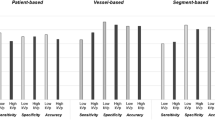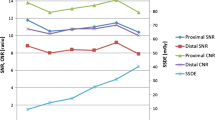Summary
The effect of low voltage and low concentration contrast agent on image quality of coronary CT angiography, radiation dose and iodine intake was evaluated. A total of 121 patients with body mass index (BMI) <26 kg/m2 and heart rate (HR) <70 beats/min were randomly divided into four groups: group A (n=31, 80 kVp, 270 mgI/mL); group B (n=33, 100 kVp, 270 mgI/mL); group C (n=30, 100 kVp, 320 mgI/mL); group D (n=27, 100 kVp, 400 mgI/mL). The automatic current modulation system and the iterative algorithm for reconstruction were adopted in each group. The CT values and SD values of the aortic root (AR), subcutaneous fat, left coronary artery opening (LCA), and right coronary artery opening (RCA) were measured in all groups, the signal-to-noise ratio (SNR) and contrast noise ratio (CNR) were calculated, and effective radiation dose and iodine intake were recorded. The subjective assessment for image quality was performed by two physicians using a 4-point scale. The results were compared using the one-way ANOVA and rank sum tests. The image quality of the four groups met the clinical diagnostic requirements. The CT values of AR in groups A, B, C, and D were 537.6±71.4, 447.2±81.9, 445.2±64.9 and 518.5±94.9 Hu, respectively, with no significant difference between group A and group D, or between group B and group C, while CT values in groups B and C were significantly lower than those in groups A and D (P<0.05). In groups A, B, C, and D, the LCA SNR values were 22.7±9.1, 23.3±9.1, 23.3±7.7 and 26.6±8.9, and the RCA CNR values were 26.9±9.8, 28.5±11.4, 27.7±8.8 and 32.1±10.6, respectively. The AR visual scores in groups A, B, C and D were 3.8±0.2, 3.9±0.3, 3.9±0.3 and 4.0±0.3, respectively. There were no significant differences in SNR, CNR and visual score among the four groups (P>0.05). The radiation doses in groups A, B, C and D were 2.6±1.4, 3.6±1.8, 4.9±3.5 and 4.9±2.8 mSv, respectively. The radiation dose in group A was significantly less than that in the rest three groups (P<0.05). The iodine intakes in groups A, B, C and D were 14.9±1.5, 15.0±1.5, 17.7±2.0 and 18.1±2.5 g, respectively. There was no significant difference in the intake of iodine between groups C and D, or between groups A and B, while iodine intake in groups A and B were significantly reduced as compared with that in groups C and D (P<0.05). It was concluded that for patients with low BMI and controlled HR, compared to 100 kVp tube voltage combined with multiple concentration contrast agents, 80 kVp combined with 270 mgI/mL contrast agent is enough to ensure the quality of the images, and can reduce the radiation dose significantly, while reducing the amount of iodine intake notably, thus reducing the incidence of adverse reaction.
Similar content being viewed by others
References
Leber AW, Johnson T, Becker A, et al. Diagnostic accuracy of dual source mult-slice CT-coronary angiography in patents with an intermediate pretest likelihood for coronary artery disease. Eur Heart J, 2007,28(19):2354–2360
Brenner DJ, Hall EJ. Computed tomography-an increasing source of radiation exposure. N Engl J Med, 2007,357(22):2277–2284
From AM, Bartholmai BJ, Williams AW, et al. Mortality associated with nephropathy after radiographic contrast exposure. Mayo Clin Proc, 2008,83(10):1095–1100
Andreini D, Mushtaq S, Conte E, et al. Coronary CT angiography with 80 kV tube voltage and low iodine concentration contrast agent in patients with low body weight. J Cardiovasc Comput Tomogr, 2016,10(4):322–326
Faggioni L, Neri E, Sbragia P, et al. 80-kV pulmonary CT angiography with 40 mL of iodinated contrast material in lean patients: comparison of vascular enhancement with iodixanol (320 mg I/mL) and iomeprol (400 mg I/mL). Am J Roentgenol, 2012,199(6):1220–1225
Modica MJ, Kanal KM, Gunn ML. The obese emergency patient: imaging challenges and solutions. Radiographics, 2011,31(3):811–823
Leipsic J, Labounty TM, Heilbron B, et al. Adaptive statistical iteratve reconstruction: assessment of image noise and image quality in coronary CT angiography. Am J Roentgenol, 2010,195(3):649–654
Van der Molen AJ, Joemai RM, Geleijns J. Performance of longitudinal and volumetric tube current modulation in a 64-slice CT with different choices of acquisition and reconstruction parameters. Physica Med, 2012,28(4):319–326
Chen MY, Shanbhag SM, Arai AE. Submillisievert median radiation dose for coronary angiography with a second generation 320-detector row CT scanner in 107 consecutive patients. Radiology, 2013,267(1):76–85
Zhang LJ, Qi L, Wang J, et al. Feasibility of prospectively ECG-triggered high-pitch coronary CT angiography with 30 mL iodinated contrast agent at 70 kVp: initial experience. Eur Radiol, 2014,24(7):1537–1546
Bongartz G, Golding SJ, Jurik AG, et al. European guidelines for multislice computed tomography: appendix c funded by the European Commission contract number FIGM-CT2000-20078-CT-TIP2004. 2015.
Oda S, Utsunomiya D, Yuki H, et al. Low contrast and radiation dose coronary CT angiography using a 320-row system and a refined contrast injection and timing method. J Cardiovasc Comput Tomogr, 2015,9(1):19–27
Higashigaito K, Husarik DB, Barthelmes J, et al. Computed tomography angiography of coronary artery bypass grafts: low contrast media volume protocols adapted to tube voltage. Invest Radiol, 2016,51(4):241–248
Zheng M, Wu Y, Wei M, et al. Low-concentration contrast medium for 128-slice dual-source CT coronary angiography at a very low radiation dose using prospectively ECG-triggered high-pitch spiral acquisition. Acad Radiol, 2015,22(2):195–202
Wu Q, Wang Y, Kai H, et al. Application of 80-kVp tube voltage, low-concentration contrast agent and iterative reconstruction in coronary CT angiography: evaluation of image quality and radiation dose. Int J Clin Pract, 2016,70Suppl 9B:B50–55
Zhang C, Yu Y, Zhang Z, et al. Imaging quality evaluation of low tube voltage coronary CT angiography using low concentration contrast medium. PloS One, 2015,10(3):e0120539
Zhang LJ, Qi L, De Cecco CN, et al. High-pitch coronary CT angiography at 70 kVp with low contrast medium volume: comparison of 80 and 100 kVp high–pitch protocols. Medicine (Baltimore), 2014,93(22):e92
Author information
Authors and Affiliations
Corresponding author
Additional information
Conflict of Interest Statement
There are no conflicts of interest.
Rights and permissions
About this article
Cite this article
Pan, Yy., Zhou, Sc., Wang, Yj. et al. Application of Low Tube Voltage, Low-concentration Contrast Agent Using a 320-row CT in Coronary CT Angiography: Evaluation of Image Quality, Radiation Dose and Iodine Intake. CURR MED SCI 40, 178–183 (2020). https://doi.org/10.1007/s11596-020-2162-8
Received:
Revised:
Published:
Issue Date:
DOI: https://doi.org/10.1007/s11596-020-2162-8




